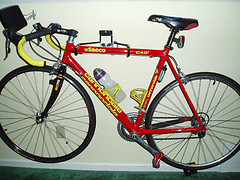
flic.kr/p/dbmzm
When you want to get the wheels in motion and take on the best Mother Nature can throw at you, take hold of a mountain bike and head for the hills.
Hands down, mountain bikes are the most rugged bicycles on the market. They are designed and built to take anything you can throw their way; from steep inclines and dirt tracks, to pebbled surfaces and hairpin bends. Most cyclists love to use their mountain bike on narrow, unpaved trails and will rarely ride on paved streets. The resulting wear and tear has forced cycle manufacturers to come up with more durable bikes that can keep performing under pressure.
Mountain bikes have fatter tires made of stronger rubber, to avoid punctures and tears from sharp rocks and obstacles along the trail. These bigger tires offer better traction, so the cyclist can enjoy a smoother ride as he or she rolls over obstacles and crosses uneven terrain.
|
Learn how to ride faster than you ever thought possible |
The suspension is an equally vital feature of mountain bikes. All good mountain bikes come with powerful suspension systems. Builders have recently begun to implement both front and rear suspension to help cyclists withstand the pitfalls of trail riding. Based on the kind of suspension they have, mountain bikes can be classified as hard tails, soft tails, fully rigid, and dual suspension bikes.
Soft tail bikes have rear suspension that rests on the pivots and frame. Hard tails versions have a front suspension fork. Rigid types have a rigid fork, and full or dual suspension bikes have both a front suspension fork and a rear suspension. These also have a rear shock absorber including a linkage.
Cross-country mountain bikes are made of more flexible material, and usually weigh less. These bikes can weigh as little as 20 pounds, with the heaviest models weighing in at about 40 pounds. Enduro or all-mountain bikes are generally heavier than cross country bikes, weighing from 30 to 50 pounds. These bikes have better suspensions that work well while maneuvering hairpin bends or climbing hills.
Free ride mountain bikes are built of heavier and stronger materials. These versions are designed for easier pedaling than other downhill bikes. They can be easily maneuvered around steep turns and dangerous obstacles, however they are not as efficient as cross-country bikes due to their hefty forty to fifty-pound weight. Downhill mountain bikes are not as strong as free ride bikes, but are best suited for riding on racecourses and downhill tracks. These versions have better traction than most mountain bikes.
Trail bikes don’t have suspension and are normally reserved for short distances. This style of mountain bike lacks a vestigial pad or a proper seat and are quite light, weighing a mere fifteen to twenty pounds. Dirt jumping, urban and street styles fall somewhere between mountain bikes and trail bikes. These bicycles are very sturdy and have one to nine gears, with a chain guide for both front and rear gears.
Riding mountain bikes is a famous way to have fun and get fit. Visit your local cycle shop for professional advice on locating the bike to best suit your cycling needs.
Tagged with: mountain bikes • road bike
Filed under: Bikes